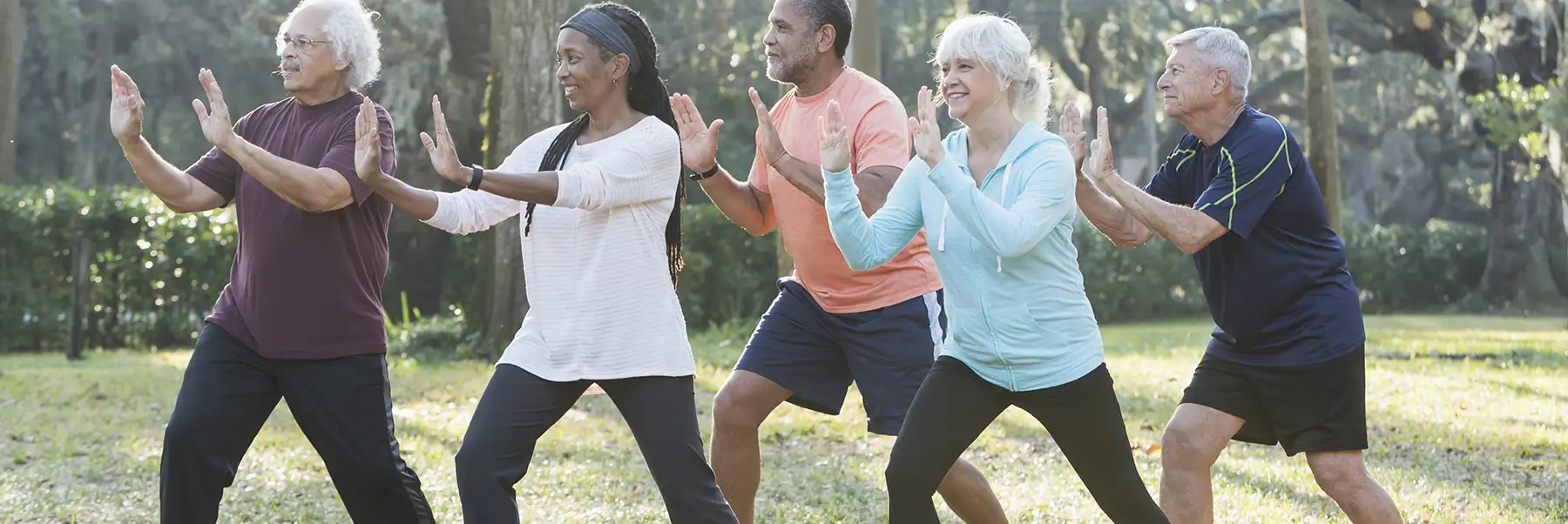Gentle Martial Art Provides Relief from Arthritic Pain

People living with arthritis are seeking new ways to ease their joint pain and stiffness without relying on over-the-counter anti-inflammatory drugs and prescription painkillers. One solution may seem innovative but is actually traditional.
What is tai chi?
Tai chi is an ancient Chinese martial art with proven benefits for those seeking to manage their arthritis pain. It is a low-impact, moderate-intensity exercise that consists of gently, slowly moving from one stance to another in a controlled, coordinated, and smooth motion with an emphasis on proper posture. There are many types of tai chi, all of which include circular motions with controlled breathing patterns.
When you’re practicing tai chi, you step one way, turn your body another, and move your arms in different directions while softly transitioning from one leg to the other. It actually looks like a slow-motion dance. These movements do not twist nor put pressure on your joints, so your knees, ankles, and other joints aren’t stressed. When appropriately practiced, tai chi poses a very low risk of injury.
How does tai chi help with arthritis pain?
While it may be counter-intuitive, regular physical activity is beneficial for those suffering from arthritis joint pain, swelling, and stiffness. Engaging in arthritis-friendly exercises like tai chi can reduce pain, improve joint flexibility, expand the range of motion and increase muscle flexibility.
“The controlled movements in tai chi can also help improve muscular strength and endurance, particularly in the lower body,” says Michelle Kasparian, an exercise specialist with the University of Miami Health System. “This can help reduce pain in the joints.”
By enhancing your flexibility, you can increase your blood and joint fluid circulation. While you may assume that muscle strength isn’t particularly important for those with arthritis, getting stronger helps protect your joints. Improving your flexibility leads to better blood and joint fluid circulation. Tai chi is also known to ease anxiety, improve focus and enhance relaxation, all of which can help to reduce the experience of physical pain.
A study released by researchers at Tufts Medical Center found that tai chi can specifically “reduce the pain and physical impairment of people with severe knee osteoarthritis.” And a study based on a tai chi program run by the Arthritis Foundation concluded that within eight weeks, participants “improved their ability to balance and reported less pain, fatigue, and stiffness.”
How do I start practicing tai chi?
Start your tai chi practice with an experienced instructor, ideally one who has previously trained arthritic participants. You can find these professionals online at local recreation and community centers, assisted living facilities, fitness gyms, yoga studios, and wellness centers.
Your tai chi instructor will tell you that starting slowly is key to this exercise and avoiding injury. Because you have arthritis, it may take more time for your body to adjust to a new level of activity.
What if it hurts?
When you incorporate tai chi into your routine, you may experience an initial increase in soreness, achiness, stiffness, and swelling in your joints and surrounding muscles. It may take up to eight weeks for your joints to accommodate your increased activity level. Being patient and consistent with your tai chi practice will give you the best long-term pain relief from arthritis.
You don’t need to worry that putting your joints and muscles to work in this way will worsen your arthritis. While your arthritis symptoms — such as pain, stiffness, and fatigue — may come and go, consistent, low-impact physical activity is far better for your body than inactivity.
Should I see my doctor?
You should already be under the regular care of a trusted healthcare professional for your arthritis. You may want to consult with your doctor before you begin your tai chi practice to discuss any concerns.
If you experience any of the following during or after practicing tai chi, it’s time to speak with your healthcare provider.
- Sharp, stabbing pain
- Pain that causes you to limp
- Pain that lasts more than 2 hours after you exercise or gets worse at night
- Pain that is not relieved by rest, medication, or hot/cold packs
- Significant increase in your joint swelling or
- Joints feel hot or become red
Dana Kantrowitz is a contributing writer for the UMiami Health News blog.
Tags: arthritic pain, arthritis, exercise, martial arts, tai chi
